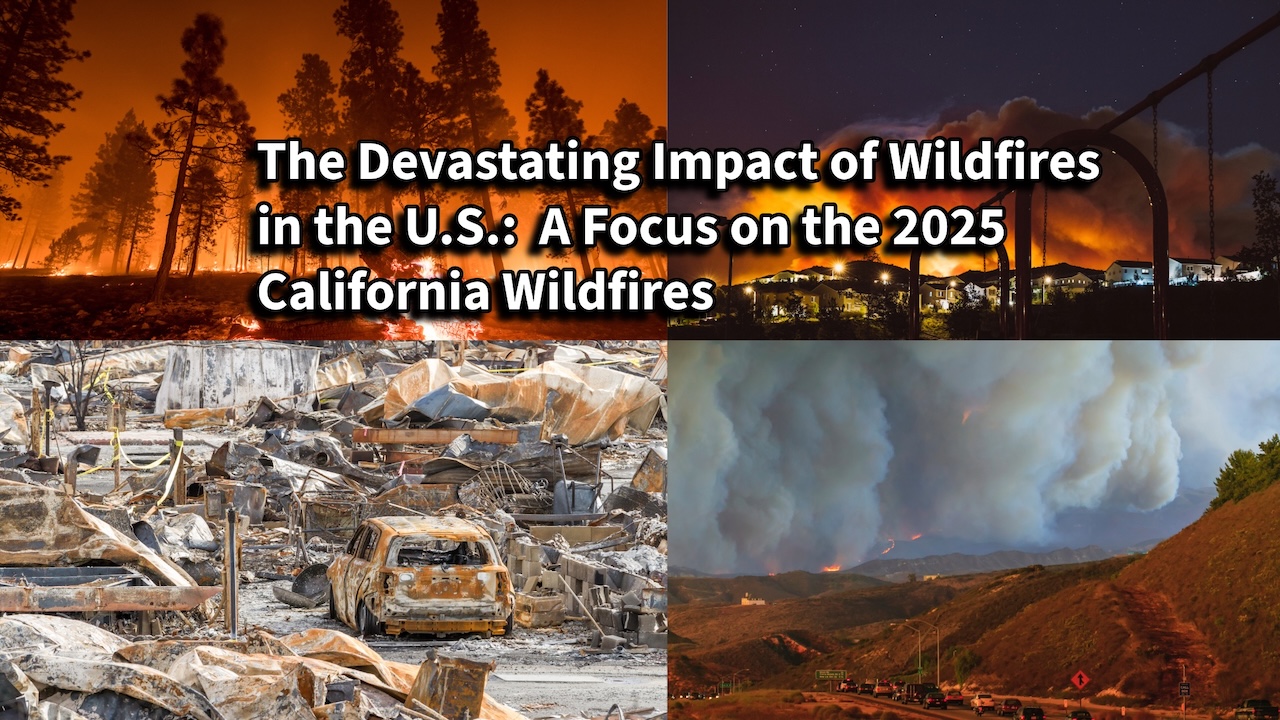The Devastating Impact of Wildfires in the U.S.: A Focus on the 2025 California Wildfires

The Devastating Impact of Wildfires in the U.S.: A Focus on the 2025 California Wildfires
Wildfires are an increasingly destructive force in the United States, causing catastrophic damage to lives, infrastructure, and ecosystems. Their frequency and intensity have grown due to climate change, urban expansion, and outdated land management practices. The 2025 California Wildfires have set a grim new benchmark, illustrating the urgent need for improved preparedness and mitigation efforts. This blog delves into the history and impacts of wildfires in the U.S., highlights the economic toll, explores the hardest-hit areas in 2025, and offers strategies for resilience.
The History and Growing Impact of Wildfires in the U.S.
Wildfires have long shaped the American landscape, but their scale and impact have escalated dramatically in recent decades. Historically, fires like the 1871 Peshtigo Fire, which killed over 1,200 people, and the 1988 Yellowstone Fires, which burned over 1.5 million acres, were seen as rare catastrophic events. However, modern factors such as prolonged droughts, higher temperatures, and poor forest management have turned wildfires into an almost annual crisis.
California, in particular, has borne the brunt of these disasters. The 2018 Camp Fire, one of the deadliest and most destructive fires in U.S. history, caused $16.5 billion in damages and devastated the town of Paradise. In comparison, the 2025 California Wildfires have surpassed previous records in both scope and economic impact. According to AccuWeather, the total damages and losses from these fires are estimated to exceed $250 billion, illustrating a new level of devastation. These fires have destroyed thousands of homes and businesses, displaced millions, and inflicted untold emotional and economic hardship.
The increasing frequency of wildfires is not just a natural phenomenon; it is a result of human choices and policies. As the Bay Area Council Economic Institute noted, “The total economic impacts of a wildfire go well beyond the cost of damages, as they include health costs and indirect losses due to power shut-offs, business closures, travel cancellations, supply chain disruptions, among other costs.” This underscores the interconnectedness of wildfire impacts, affecting sectors far beyond the immediate fire zones.
The Economic Toll: Businesses, Governments, and Individuals
Wildfires impose an immense economic burden that ripples across every level of society. Businesses, governments, and individuals all bear the costs, which are far-reaching and multifaceted.
Impact on Businesses
For businesses, wildfires disrupt operations, destroy physical assets, and sever supply chains. Small businesses are particularly vulnerable, often facing closure due to uninsured losses or prolonged downtime. In the 2025 wildfires, industries such as agriculture, technology, and tourism have been severely affected. Entire communities dependent on these industries are grappling with unemployment and financial instability. The Bay Area Council Economic Institute’s findings on indirect losses, such as business closures and supply chain disruptions, highlight how far-reaching these impacts can be.
Government Expenditures
Governments face significant costs from wildfires, including firefighting expenses, emergency response efforts, and long-term recovery initiatives. The 2025 wildfires prompted the largest insurance payouts in California’s history, with estimates exceeding $20 billion, according to Fox Business. This places immense strain on state and federal budgets already stretched thin by recurring climate-related disasters. FEMA has provided federal disaster assistance, including grants for temporary housing and low-cost loans, to help individuals and businesses recover.
Challenges for Individuals
For individuals, the loss of homes and personal belongings is only part of the story. Rising insurance premiums, long-term health issues from smoke exposure, and emotional trauma compound the challenges faced by wildfire survivors. FEMA’s assistance programs have been a lifeline for many, but the scale of the crisis often outpaces available resources. “FEMA announced that federal disaster assistance is available to supplement recovery efforts in the areas affected by wildfires,” underscoring the critical role of federal support.
Hardest-Hit Locations in the 2025 California Wildfires
Southern California has been particularly devastated by the 2025 wildfires. The Palisades Fire, one of the largest blazes, remains largely uncontained and has already destroyed thousands of properties. More than 6 million residents in the region have been affected, with many forced to evacuate.
Key Statistics:
-
Economic Losses: Estimated at $275 billion, making it the costliest wildfire disaster in U.S. history (AccuWeather).
-
Human Impact: Dozens of fatalities, hundreds of injuries, and millions displaced.
-
Property Damage: Thousands of homes and businesses reduced to ash.
When compared to historical events like the 2018 Camp Fire, which caused $16.5 billion in damages, the 2025 wildfires underscore the increasing scale and intensity of these disasters. The Guardian highlighted the unique challenges faced by Southern California, noting that “prolonged drought and the seasonal Santa Ana winds have created a particularly dangerous situation.”
Nonprofits and Relief Efforts
Amid the devastation, numerous organizations have mobilized to support wildfire victims. These nonprofits are providing essential supplies, shelter, and emotional support to those affected.
-
Direct Relief: This organization is distributing medical supplies, N95 respirators, and other essentials to impacted communities. As they state, “Direct Relief is coordinating with local and regional agencies and organizations, as well as health centers and free clinics in and around Los Angeles.”
-
American Red Cross: The Red Cross has set up shelters, provided meals, and deployed over 200 disaster workers to assist evacuees.
-
Convoy of Hope: Through their Crisis Relief Fund, Convoy of Hope is delivering food, water, and emergency supplies to affected areas.
-
Los Angeles Regional Food Bank: This food bank is accepting donations to help families displaced by the fires.
These organizations rely on public support to sustain their efforts. Donations of money, supplies, and volunteer time are crucial for enabling them to meet the growing needs of affected communities.
Strategies for Minimizing Wildfire Impacts
Wildfires may be inevitable, but their impacts can be mitigated through proactive measures. Businesses and individuals both have roles to play in building resilience.
For Businesses:
-
Preparedness Plans: Develop comprehensive wildfire response plans, including evacuation protocols and backup operations.
-
Insurance: Ensure adequate coverage that includes wildfire-related losses.
-
Remote Work: Establish policies to allow employees to work remotely during fire seasons, minimizing disruptions.
For Individuals:
-
Home Hardening: Use fire-resistant materials for roofs, siding, and landscaping to reduce fire risks.
-
Emergency Kits: Keep kits stocked with essential supplies, including food, water, and important documents.
-
Evacuation Preparedness: Familiarize yourself with evacuation routes and practice emergency drills.
Frontline Wildfire’s real-time fire maps are invaluable tools for monitoring risks and planning evacuations. They encourage users to “zoom and scroll to explore the CA wildfire map,” providing a critical resource for staying informed.
References/Bibliography
-
The True Cost of Wildfires – Bay Area Council Economic Institute
-
AccuWeather Estimates $250 Billion in Damages – AccuWeather
-
California Wildfires Could Cost Insurers $20B – Fox Business
-
California Wildfire Map – Frontline
-
Direct Relief Wildfire Efforts – Direct Relief
-
American Red Cross Wildfire Relief – American Red Cross
-
Convoy of Hope Crisis Relief Fund – Convoy of Hope
-
LA Food Bank Donations – Los Angeles Regional Food Bank
Wildfires are a growing challenge that demands coordinated action. By understanding their impact, supporting relief efforts, and adopting proactive measures, we can reduce the devastation they cause and build a more resilient future.

